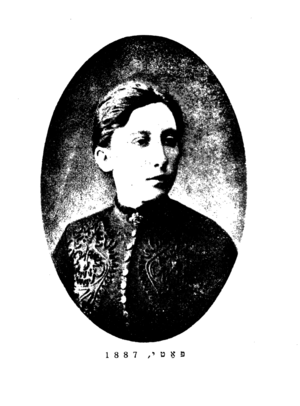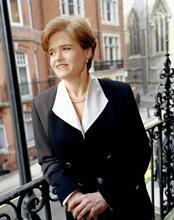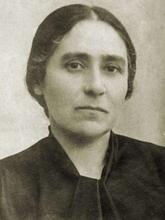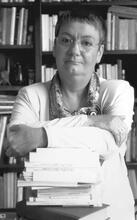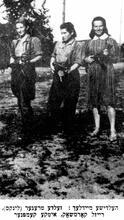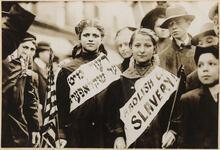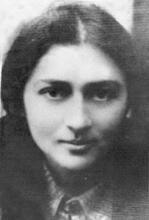Pati Kremer
Pati Kremer belonged to the pioneer generation of Eastern European Jewish women who broke with traditional roles to pursue careers as well as political activism in a left-wing labor party. Motivated from a young age to combat social and economic injustices in her hometown of Vilna, Kremer began tutoring young women textile workers in reading and writing. Later, she became acquainted with the Jewish labor movement, first through the Vilna Group then through the General Jewish Labor Bund. As a Bundist in Tsarist Russia, Kremer faced arrest and exile but stayed committed to the cause through her work as an editor and translator, among other activities. While imprisoned in the Vilna Ghetto during World War II, she continued her work underground until her death in 1943.
Pati Kremer, née Matla Srednicki, was one of the legendary pioneers of the Jewish workers’ movement in Eastern Europe. Already in the 1890s an active member of the so-called Vilna Group, the precursor to the General Jewish Labor Bund, she remained closely associated with the Jewish workers’ party until her death in the Vilna Ghetto.
Early Life and Contact with the Vilna Group
Pati Kremer was born in Vilna on January 2, 1867, the daughter of a well-to-do merchant. She spent a carefree childhood, her intellectual and linguistic talents nurtured by study at the academic secondary school in Vilna. While still in her teens, however, Pati became aware of the misery in which Jewish working-class families lived, and was motivated to engage in social activism. As a fifteen-year-old she began teaching young female textile workers to read and write, overcoming the opposition of the girls’ mothers, who considered this a waste of time. After completing secondary school Pati Kremer moved to Saint Petersburg to train as a dentist. In the Russian capital she came into contact with the revolutionary movement of the late Tsarist Empire. This involvement earned her a prison sentence in the late 1880s, after which she was able to return to Vilna in 1890 under police escort.
Back home, she played an active role in the work of the Jewish Social Democratic Group, also known as the Vilna Group, whose members included workers and intellectuals, among them her future husband Arkadi Kremer (1865–1935) and John Mill (1870–1952), who described Pati Kremer in the following words: “Pati Srednicki, whom an outside observer would probably have considered a carefree girl full of joie de vivre, a butterfly flitting carelessly from place to place, was in reality tireless in those days, constantly occupied with important work for the Party, ... like a ‘busy body’ [sic; English in the original].” Her dental practice in Vilna was the meeting place of the local Jewish Socialists, who often posed as patients. She herself performed various, mainly practical, political tasks, inter alia participating in the organization of the workers’ clubs and strike funds that were the forerunners of the Jewish trade union movement. Her knowledge of languages also made her a much sought-after translator of political literature. She married Arkadi Kremer during this period.
Bundist Activism: Exile, Arrest, and Editorship
In September 1897, just a few weeks after the founding of the Bund in Vilna, Pati Kremer was arrested again. This time she was banished to Belorussia, near the city of Mogilev. There, too, she was active in the Jewish workers’ movement together with other exiles, and participated illegally in the Bund’s second party congress in Kovno in 1898, after the arrest of the first Bund Central Committee (including Arkadi Kremer). She and her husband succeeded in escaping abroad only in 1902—a journey that took them to London, the USA, Switzerland and France. The Kremers returned to Vilna in 1921.
Arkadi and Pati Kremer did not at first occupy leading positions in the interwar Bund in Vilna. This changed only in the late 1920s, when Arkadi Kremer took over the chairmanship of the Vilna Bund organization. In the first half of the 1920s Pati Kremer devoted herself mainly to her work as an editor in the publishing company owned by the Bundist Boris Kletskin (1875–1937). After Arkadi Kremer’s death in 1935, Pati Kremer participated in the publication of a commemorative book, which appeared in New York only in 1942.
Still the “Soul of the Bund”: Life and Death in the Vilna Ghetto
In the Vilna Ghetto, Pati Kremer once again became the “soul of the Bund,” to use John Mill’s phrase. In his moving Diary of the Vilna Ghetto, Herman Kruk describes the special role that the now elderly Bund veteran played there. As part of underground cultural work in the ghetto, she took part in illegal readings and in the maintenance of illegal Jewish libraries. When the Vilna Ghetto was closed down in September 1943 and its inhabitants rounded up before being murdered in the extermination camp of Sobibor or the forest of Ponary, eyewitnesses reported that Pati Kremer called upon them to sing the Bund anthem Di Shvue (The Oath) on the way to their death. She thus remained loyal to her party until the very end.
Pati Kremer belonged to the pioneer generation of Eastern European Jewish women who broke with traditional roles, pursued independent paid employment, and combined their sensitivity to social issues with political activism in a left-wing labor party. Although she was not involved in the theoretical conceptualization of the Bund, instead devoting herself to more practical tasks, her social competence and her intimate familiarity with the Yiddish language made her an indispensable link between intellectuals and simple proletarians, particularly in the early phase of the organized Jewish labor movement. Her great period was that of underground work in the Russian Empire. Her life ended tragically in the underground of the Vilna Ghetto.
Kremer, Pati. Zikhroynes vegn Arkadin. Arkadi . Zamlbukh tsum ondenk fun Arkadi Kremer (Memories of Arkadi. A Collection Commemorating Arkadi Kremer) (Yiddish). New York: Unser Tzayt, 1942, 22–72.
Davies-Kram, Harriet. “The Story of the Sisters of the Bund.” Contemporary Jewry V, no. 2 (1980): 27–43.
Fieseler, Beate. “The Jewish Legacy and Social Democracy: Women in the Bund and the Russian Social Democratic Workers’ Party at the Turn of the Century.” In Bund—100 lat historii 1897-1997 (Bund—100 Years of History. 1897–1997), edited by Feliks Tych and Juergen Hensel, 187–199 (Polish). Warsaw: Erich Brost Foundation in the Friedrich Ebert Foundation, 2000.
Hertz, J.S., editor. Doyres bundistin (Generations of Bundists) (Yiddish), vol.1. New York: Unzer Tsayt, 1956, 130-137.
Kruk, Herman. Tagbukh fun Vilner Geto (Diary of the Vilna Ghetto) (Yiddish). New York: YIVO, 1961.
Mill, John. Pionern un boyer memuarn (Pioneers and Builders) (Yiddish). New York: Der yeker, 1964.
Tobias, Henry. The Jewish Bund in Russia. From its Origins to 1905. Stanford: Stanford University Press, 1972.
Zshelesnikov, A. “The Last Years with Comrade Pati” (Yiddish). Unzer Shtime, September 23, 1950.

